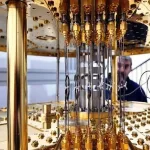Jerusalem, 21 October, 2025 (TPS-IL) — Dark matter may once again be the key to explaining one of astronomy’s most enduring puzzles: the mysterious glow of gamma rays at the Milky Way’s center. A new international study led by Israeli, British, and German scientists has revived the theory that dark matter could be behind the high-energy radiation first detected more than a decade ago.
Dark matter is a mysterious, invisible form of matter that scientists believe makes up about 85% of all matter in the universe. Unlike ordinary matter — the stuff that makes up stars, planets, and people — dark matter does not emit, absorb, or reflect light, which is why it can’t be seen directly with telescopes.
For years, scientists have puzzled over the so-called “Galactic Center Excess,” an unexpected concentration of gamma rays coming from the Milky Way’s heart. Some scientists believe collisions or annihilations between dark matter particles could produce gamma rays, potentially explaining the mysterious glow at the Milky Way’s center. But later analyses suggested the rays’ spatial pattern didn’t fit the smooth, spherical halo expected from dark matter. Many researchers turned instead to a more conventional source: a hidden population of ancient, rapidly spinning neutron stars called millisecond pulsars.
Researchers from the Hebrew University of Jerusalem, the Leibniz Institute for Astrophysics Potsdam (AIP), and Oxford University found that the galaxy’s past mergers and collisions could have reshaped its dark matter, offering a new way to explain the long-debated gamma-ray signal.
The research, published in the peer-reviewed Physical Review Letters, used advanced cosmological simulations to model how the Milky Way’s violent early history may have shaped the distribution of dark matter in its core. The team was led by Dr. Moorits Muru, together with Dr. Noam Libeskind and Dr. Stefan Gottlöber of AIP, Professor Yehuda Hoffman of Hebrew University’s Racah Institute of Physics, and Professor Joseph Silk of Oxford University.
The findings show that dark matter might not be distributed as previously thought. Using a suite of detailed simulations known as Hestia, which recreate galaxies under conditions similar to our own cosmic neighborhood, the researchers traced the Milky Way’s formation through its early mergers and turbulent growth. Those events, they found, could have stretched and distorted the dark matter in the galactic core into a more complex, nonspherical shape—one that closely matches the gamma-ray pattern observed by NASA’s Fermi Gamma-ray Space Telescope.
“The Milky Way’s history of collisions and growth leaves clear fingerprints on how dark matter is arranged at its core,” the researchers said. “When we account for that, the gamma-ray signal looks a lot more like something dark matter could explain.”
That insight represents a significant shift. Rather than treating dark matter as static and evenly distributed, the study links the galaxy’s dynamic history to a present-day observable phenomenon — suggesting that the central glow may actually preserve clues to how the Milky Way was built.
The findings don’t settle the debate, but they restore dark matter as a serious contender for explaining the mysterious radiation. Upcoming observatories such as the Cherenkov Telescope Array, which will probe even higher-energy gamma rays, are expected to test the theory more decisively.
“This study gives us a fresh way to interpret one of the most intriguing signals in the sky,” the authors said. “Either we’ll confirm that dark matter leaves an observable trace—or we’ll learn something entirely new about the Milky Way itself.”



























